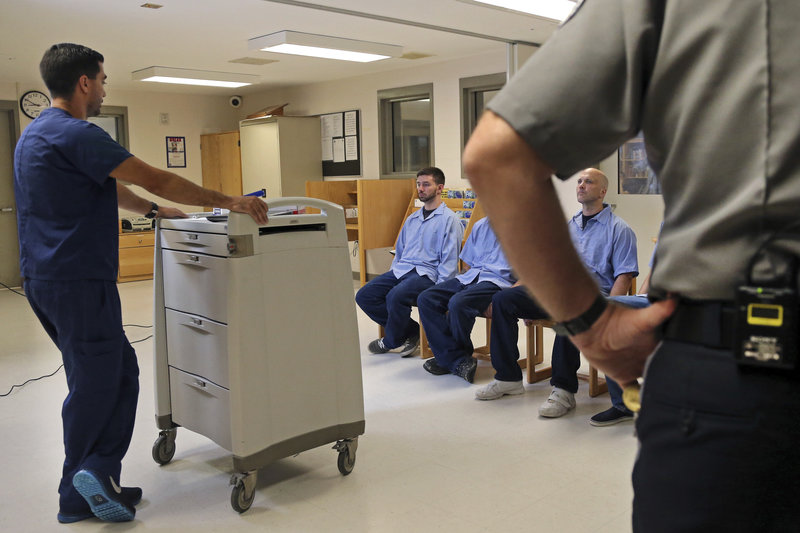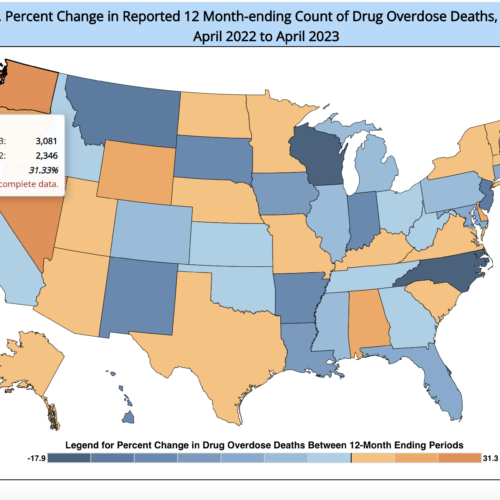
County Jails Struggle With A New Role As America’s Prime Centers For Opioid Detox

listen
BY ERIC WESTERVELT
Faced with a flood of addicted inmates and challenged by lawsuits, America’s county jails are struggling to adjust to an opioid health crisis that has turned many of the jails into their area’s largest drug treatment centers.
In an effort to get a handle on the problem, more jails are adding some form of medication-assisted treatment, or MAT, to help inmates safely detox from opioids and stay clean behind bars and after release.
But there are deep concerns about potential abuse of the treatment drugs, as well as worries about the efficacy and costs of programs that jails just weren’t designed or built for.
“It was never traditionally the function of jail to be a treatment provider, nor to be the primary provider of detoxification in the country — which is what they have become,” says Andrew Klein, the senior criminal justice research scientist with the company Advocates for Human Potential, which advises on jail and prison substance abuse treatment programs across the U.S. “So, with the opioid epidemic, jails are scrambling to catch up.”
A “Critical Situation”
The National Sheriffs’ Association estimates that at least half to two-thirds of today’s jail population has a drug abuse or dependence problem. Some counties say the number is even higher.
“We are in a critical situation,” says Peter Koutoujian, a leading voice on the issue and the sheriff of Middlesex County, Mass. — one of the states hardest hit by the opioid epidemic.
“We have to physically, medically detox about 40% of our population as they come in off the street,” he says, “and probably 80 to 90% of our population inside has some type of drug or alcohol dependence.”
Koutoujian, who is also vice president of the Major County Sheriffs of America, says how best to treat opioid-addicted inmates is among the most pressing issues facing jails today.
“We have not been able to get our hands around it because, quite honestly, society has not gotten its hand around either preventing [drug-addicted] people from coming into our institutions or supporting them once they get back outside,” he says.
“The fact is you shouldn’t have to come to jail to get good [treatment] programming,” says Koutoujian. “You should be able to get that in your own community so you don’t have to have your life disrupted by becoming incarcerated.”
An ever-growing number of jails — 85 percent of which are run by local sheriffs — are trying to expand the use of medication-assisted addiction treatment behind bars, including the use of buprenorphine and methadone, among other drugs.
“Dead Addicts Don’t Recover”
Jails in states hardest hit by opioids — including Ohio, Kentucky, West Virginia, Rhode Island and Massachusetts — are moving fastest to expand this use of medicine, which is now widely considered the most effective method of treating opioid use disorder. The National Sheriffs’ Association recently put out a detailed best practices guide to jail-based medication-assisted treatment, in conjunction with the National Commission on Correctional Health Care.
“Dead addicts don’t recover. So this is our opportunity to engage this population,” says Carlos Morales the director of correctional health services for California’s San Mateo County, just south of San Francisco.
Morales is working to expand access to medications for an older model of drug treatment that has long relied on abstinence and a “cold turkey” approach.
“We know if you are an opiate user you come in here, you detox, and you go out — it’s a 40 percent chance of OD-ing,” Morales says. “And we have the potential to do something about it.”
Felipe Chavez, who’s doing time at the San Mateo jail for selling fentanyl, is taking part in the jail’s fledgling opioid treatment program. Chavez says opioids have ruled his life since he started using oxycodone pills at age 12, following an injury.
“I was smoking them,” Chavez says. “Then I went to heroin. Then heroin went to fentanyl.”
With his sleepy eyes and loose-fitting clothes, Chavez looks younger than his 23 years – a little like a teenager in baggy pajamas. But the bright hunter-orange of everything he’s wearing, down to the plastic Crocs, all signify he’s in the San Mateo County jail’s infirmary in Redwood City, Calif., where he gets his regular dose of methadone.
Still, Chavez is one of the lucky ones here. Because he was in a local methadone program before he got arrested — again — he has been allowed to keep using that synthetic opioid substitute in jail. Methadone and a couple other drugs help jailed opioid users like Chavez temper cravings and, in theory, stay off more powerful and destructive opioids.
“It’s all about if you want to get clean or not, you know,” Chavez says. “The methadone is just there to help, you know. I mean, you’ve got to dedicate to the methadone. Because you got to start somewhere.”
With the methadone treatment he says, “I just feel more normal — like a normal person.”
Jail As An “Opportunity To Intervene”
Doctors who treat people in jails say a challenge — and an opportunity — in expanding the use of methadone or another medical treatment is that it’s not clear, at first at least, how big a role opioid addiction is playing in an inmate’s troubles; their drug use is often intertwined with mental health problems.
“The opiate part of the problem is usually not part of the charging documents, so it’s hard to tell,” says Dr. Robert Spencer, San Mateo County’s correctional health medical director. Addiction, mental health and crime “are so intimately connected,” Spencer says. “It’s often a form of self-medication, an attempt by them to modify their symptoms. This gives us an opportunity to provide an intervention and a possible way forward.”
More research is needed to confirm the long-term benefits of treating addiction in jail, addiction specialists say. But, so far, studies have shown that medication-assisted treatment works well in reducing fatal overdoses, relapse and in reducing the spread of infectious diseases, such as HIV.
Still, this kind of medication-based approach is relatively new in San Mateo — as it is for many jails across the country. For nearly a quarter century, San Mateo’s flagship addiction treatment program has been an abstinence-based approach called Choices. So far, only a dozen or so of the jails’ roughly 1,000 inmates are undergoing some sort of medication-assisted treatment.
Correctional health director Morales wants to expand those numbers. But he has lingering worries about costs, effectiveness and safety. He says inmates can hoard — and then sell, trade or abuse — some of the opioid treatment drugs, which are among the most top contraband items in jails today.
In addition, prison reforms in California to reduce overcrowding and reclassify some sentences has resulted in county jails housing more inmates for longer periods.
That, Morales says, has increased a kind of recidivist merry-go-round: a growing number of inmates with multiple bookings and short jail stays; people who aren’t getting the treatment they often need.
“I don’t think our script is good yet,” he says. “We don’t explain it well [to inmates], and we have to get better at advocating that someone use medicated-assisted treatment — and to get the protocol right, so that it’s not isolated folks that are doing it.”
Jails need to build the momentum of routine treatment by getting staff and inmates who have been helped talking about the success of this approach, he says. “And frankly, we’re not scaled up enough. Those are the challenges that we’re facing.”
It’s a similar story nationally, where the number of jails offering medication for inmates who are addicted is small.
Only 10% to 12% of the nation’s 4,000 jails are trying some form of addiction medication as part of treatment.
“Although this number is not the majority of jails, five years ago it was zero,” says Klein. “And the number is increasing every week.”
Some are offering access to the opioid substitute drugs buprenorphine and methadone, which can help opioid users detox and then temper cravings. Long term, in theory, those drugs can help people who have become addicted to opioids stay off of destructive and potentially deadly street versions.
But the majority of jail-based medication-assisted treatment programs today are limited to injectable naltrexone, given upon an inmate’s release.
Also known by its brand name Vivitrol, naltrexone is an injectable drug that could trigger withdrawal symptoms in someone who is physically dependent on opioids; but it also blocks the brain’s receptors for opioids and alcohol for 28 days.
Inmates who have been addicted to opioids are at far greater risk for overdose upon release, as their tolerance for street drugs is often greatly reduced after a stint of abstinence. Suddenly, a dose that got them high in the old days could now be fatal.
Liability concerns and the need to improve withdrawal management are also driving the increase in medication-assisted treatment. About 80%
. of all detoxification for drugs and alcohol happen in jails and prisons. And nationally, in the last 10 years, counties and states have paid out well over $70 million for addiction withdrawal-related deaths of inmates, according to a tally by Klein. More than 50 similar lawsuits are still pending.
Klein says the challenge is far broader than jails for a public health system that has yet to catch up to the opioid crisis. “MAT is totally underutilized in the community, much less in jails,” he says.
The problem is particularly hard for jails in more rural and semi-rural counties, which often have limited access to medications, to physicians who will administer it, and to follow-up programs that inmates can tap into upon release.
To provide methadone, for example, a jail has to either be certified as a methadone clinic or partner with a community clinic.
“Even if [rural jails] wanted to provide medication-assisted treatment within the jails, there may not be a methadone clinic for 60 miles,” says Carrie Hill, director of the National Sheriffs’ Association’s center for jail operations. “It’s a huge issue.”
Or a county may not have a doctor with the necessary licenses to provide treatment medications, Hill says.
Most rural areas “don’t have a single doctor who is certified to even prescribe buprenorphine,” says Klein. “So it’s very difficult for a jail to even find a doctor who can prescribe it to an inmate who may need it. Most rural and suburban counties in this country don’t have any methadone clinics they can rely on.”
Hill says the sheriffs in her group are working on ways to expand treatment and recovery support services to rural areas, including city-rural treatment partnerships; additional funding to greatly expand telemedicine and broadband services; and mobile anti-opioid addiction units that could deliver treatment drugs to hard-to-reach jails.
The group is in conversation with its federal partners to get the necessary medical waivers to do that.
Advocates for expanding MAT say the medications are saving lives. “In jail, [when] we have somebody stabilized — off street drugs — they can begin to calm down and [we can] find out if we can help them with medication,” Klein says. “What a tragedy if we miss that moment.”
The legislature in Massachusetts, with Koutoujian’s encouragement, has given the green light for a seven-county pilot program of the best evidence-based opioid treatment in jails. Starting this August, the jails will offer all forms of medication-assisted treatment and carefully track data on efficacy — including rates of drug relapse, overdose and recidivism.
While he supports MAT in general, Koutoujian, the sheriff, says he’s wary that medications alone will solve the inmate addiction treatment problem. That kind of thinking, he says, got us into this crisis in the first place.
“Medication-assisted treatment is very important but people have to remember if you do the medication without the treatment portion — the counseling and the supports — it will fail. And we will just fall prey to another easy solution that just simply does not work.”
“We have to make sure, if we are going to use medication-assisted treatment,” Koutoujian says, “that when they leave our facility they will have access to medication. Do they have health insurance to cover that medication? Do they have access to counseling and treatment services and navigators to help them through this most difficult time period? If they don’t have that, then in many ways we could be setting them up for greater failure.”
Meanwhile, in San Mateo’s jail, inmate Felipe Chavez says he wants to serve his time, reconnect with an infant daughter he barely knows and try “to live a different life.”
“I mean, I know everyone says that while they’re in here,” Chavez says. “But, you know, I’m really trying to just get my family back together. Change the way of life.”
To do that, Chavez says, for now he wants to stay in the jail’s fledgling medication-assisted treatment program — to help him stay off fentanyl and stay alive.
Copyright 2019 NPR. To see more, visit npr.org
Related Stories:

Two bills could make it easier for people in Washington state custody to vote, politically organize
A person walks near the Legislative Building, Wednesday, April 21, 2021, at the Capitol in Olympia, Wash. (Credit: Ted S. Warren / AP) Listen (Runtime 1:04) Read While people who

Where Walla Walla’s opioid settlement funds are going
The CARES team offers mobile medical and mental health support to residents of Walla Walla. When their work involves opioids, they can bill their time to the opioid settlement fund.

Federal funds to battle opioid addiction coming to rural western Washington hospitals
For people seeking medication-assisted treatment for substance use disorder in some rural Washington communities, there could soon be more options. Recent grant funding from the U.S. Department of Health and Human Services has been allocated to develop medication-assisted treatment (MAT) at rural clinics.















